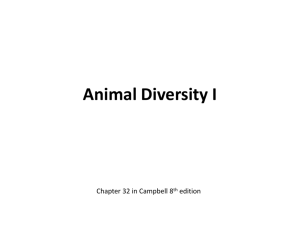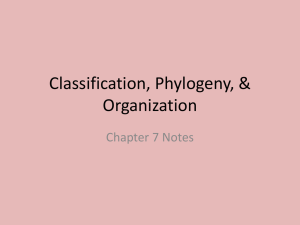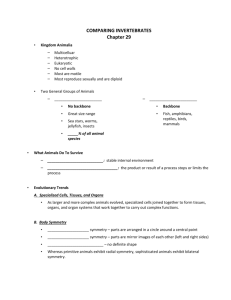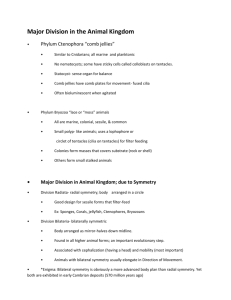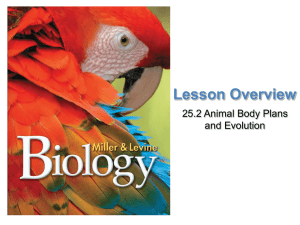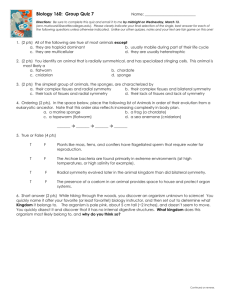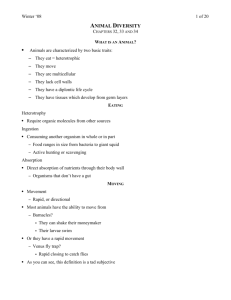Characteristics of Animals
advertisement
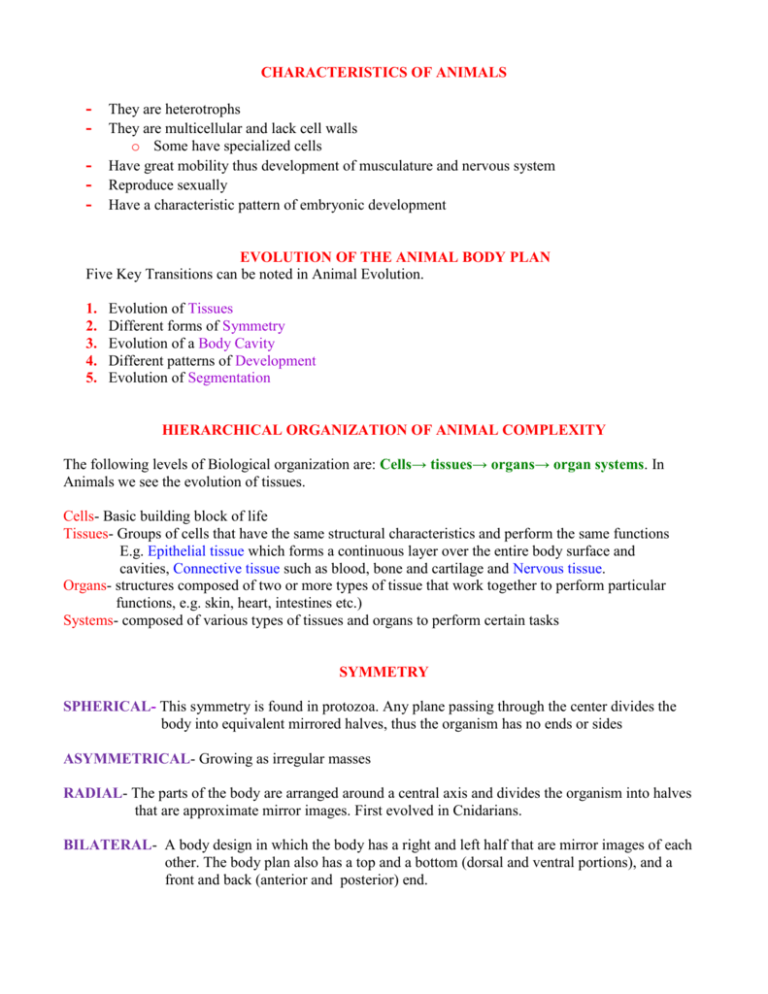
CHARACTERISTICS OF ANIMALS - They are heterotrophs - They are multicellular and lack cell walls o Some have specialized cells - Have great mobility thus development of musculature and nervous system - Reproduce sexually - Have a characteristic pattern of embryonic development EVOLUTION OF THE ANIMAL BODY PLAN Five Key Transitions can be noted in Animal Evolution. 1. 2. 3. 4. 5. Evolution of Tissues Different forms of Symmetry Evolution of a Body Cavity Different patterns of Development Evolution of Segmentation HIERARCHICAL ORGANIZATION OF ANIMAL COMPLEXITY The following levels of Biological organization are: Cells→ tissues→ organs→ organ systems. In Animals we see the evolution of tissues. Cells- Basic building block of life Tissues- Groups of cells that have the same structural characteristics and perform the same functions E.g. Epithelial tissue which forms a continuous layer over the entire body surface and cavities, Connective tissue such as blood, bone and cartilage and Nervous tissue. Organs- structures composed of two or more types of tissue that work together to perform particular functions, e.g. skin, heart, intestines etc.) Systems- composed of various types of tissues and organs to perform certain tasks SYMMETRY SPHERICAL- This symmetry is found in protozoa. Any plane passing through the center divides the body into equivalent mirrored halves, thus the organism has no ends or sides ASYMMETRICAL- Growing as irregular masses RADIAL- The parts of the body are arranged around a central axis and divides the organism into halves that are approximate mirror images. First evolved in Cnidarians. BILATERAL- A body design in which the body has a right and left half that are mirror images of each other. The body plan also has a top and a bottom (dorsal and ventral portions), and a front and back (anterior and posterior) end. GERM LAYERS A germ layer is a group of cells, formed during animal embryogenesis. Germ layers are particularly pronounced in the vertebrates; however, all animals more complex than sponges (eumetazoans and agnotozoans) produce two or three primary tissue layers (sometimes called primary germ layers). Animals with radial symmetry, like cnidarians, produce two germ layers (the ectoderm and endoderm) making them diploblastic. Animals with bilateral symmetry produce a third layer between these two layers (appropriately called the mesoderm) making them triploblastic. Germ layers eventually give rise to all of an animal’s tissues and organs through the process of organogenesis. Ectoderm- forms the skin and nervous system Endoderm- forms the digestive tract Mesoderm- produces muscular tissue and parts of the reproductive and circulatory system Examples Of Our Various Levels Of Organization 1. Protoplasmic- all functions are confined to a cell e.g Unicellular Protists 2. Cellular- aggregation of cells that are functionally differentiated Examples: Group: Parazoa (Animals that lack specialized tissues) Phylum: Porifera (Sponges) Genus: Genus- Grantia - - Very simple morphology but they are highly adaptive and have survived for thousands of years Their morphology allows for acquiring nutrients and reproduction They are eukaryotic, multicellular and heterotrophic Their body plan is asymmetrical (no symmetry or pattern, i.e no left or right halves etc.) They do not have distinct tissues or organs instead are just made up of aggregates of cells that can differentiate and de-differentiate o Therefore the cells can separate from each other and can gather back together again to form a functioning organism o Each disassociated cell can also survive on its own Grantia have tubular bodies with open ended chambers, and possess pores for filtering H20 http://www.ips.it/scuola/concorso/ambiente/grantia.jpg 3. Cell-Tissue – cells are aggregated into patterns/layers forming tissues Example: Group: Radiata (Animals that have radial symmetry) Phylum: Cnidaria (Sea Anemones) Genus: Genus- Metridium - Cnidarians are marine carnivores and include hydras, jellyfish, anemones and corals - exhibit radial symmetry and thus are more complex than sponges - Cnidarians possess ‘true tissues’ which include rudimentary nervous, muscular, and reproductive tissues, but no organs - Metridium is a type of sea anemone which is characterized by numerous tentacles that extend from atop a smooth cylindrical base, and can vary from a few centimeters in height or up to several meters http://rydberg.biology.colostate.edu/Dissections/metridium.htm http://homepage.uab.edu/acnnnghm/BY255L/BY255LImages/BY255LImages-Cnidaria/Metridium-2.jpg Gonads Jellyfish 4. Tissue- Organ – cells are aggregated into patterns/layers forming tissues Example: Group: Bilateria (Animals that have bilateral symmetry) Phylum: Platyhelminthes (Flatworms) Genus: Genus- Dugesia (Planarian) - Platyhelminthes occur in marine, freshwater, terrestrial and parasitic environments - they have a cellular mesoderm in addition to an ectoderm and endoderm - Dugesia (planaria) has lateral lobes and sensory organs called eyespots in addition to a rudimentary digestive system and a pharynx 5. Organ-System – organs work together to perform a coordinated function Example: Group: Bilateria (Animals that have bilateral symmetry) Phylum: Chordata (Chordates, such as fish, amphibians and reptiles) Genus: Genus- Perca (Perch) - The perch belongs to Class Osteichthyes (Bony Fish) whichmeans they have a bony endoskeleton, - - - modified gill arches. The perch organ systems include a digestive, circulatory, urinary and reproductive system BODY CAVITIES The evolution of the body cavity in bilateral symmetrical organisms facilitated the support and housing of organs, along with aiding distribution of materials in the body and specific embryonic development patterns. o Thus the development of advanced organ systems A body cavity refers to a space surrounded by mesodermal tissue There are three types of body plans, Acoelomate, Pseudocoelomate and Coelomate. 1. Acoelomates - Have no body cavity between the mesoderm and the endoderm, instead there is a solid mass of tissue composed of cells and organic material Example: Group: Bilateria (Animals that have bilateral symmetry) Phylum: Platyhelminthes (Flatworms) Genus: Genus- Dugesia (Planarian) - Planaria have no body cavity besides their digestive cavity, andit allows for regeneration 2. Pseudocoelomates - Possess a body cavity called a pseudocoel that is found between the mesoderm and the endoderm Example: Group: Bilateria (Animals that have bilateral symmetry) Phylum: Nematoda (Roundworms) Genus: Genus- Ascaris - Ascaris is a parasitic roundworm that infects the intestinal tract of many vertebrates including humans - Male Ascaris are usually smaller than the females, and posses a hooked posterior end 3. Coelomates - Possess a fluid-filled body cavity entirely within the mesoderm called a coelom. - Many organ systems are suspended in the coelom which is surrounded by a layer of epithelial cells Example: Group: Bilateria (Animals that have bilateral symmetry) Phylum: Annelidia (Segmented Worms e.g earthworms and leeches) Genus: Genus- Lumbricus (earthworms) - The Phylum Annelida is defined by the division of the body into repetitive segments o Each segment contains parts of the circulatory, digestive, nervous and excretory systems BILATERIANS AND DEVELOPMENT Bilaterians can be further divided into two groups according to their basic pattern of development. The two groups are Protosomes and Deuterosomes. 1. Protosomes - The mouth develops before the anus - Some examples of protosomes includes flatworms, nematodes and mollusks - Protosomes also display Determinate development o Determinate development results in the developmental fate of the cells being set early in the embryo development. Each cell produced by early embryonic cleavage does not have the capacity to develop into a complete embryo. 2. Deuterosomes - The anus develops before the mouth - Some examples of deuterosomes include the Phylum Echinodermata (sea stars, urchins, sea - cucumbers), and the Phylum Chordata ( fish, reptiles, birds, mammals,and amphibians) Deuterosomes display Indeterminate dvelopment o The fate of the cell is not predetermined, thus when the original cell in a deuterostome embryo divides, the two resulting cells can be separated, and each one can individually develop into a whole organism. Describing Positions Dorsal- toward the upper surface (back) Ventral – toward the lower surface (belly) Anterior - toward the head Posterior- toward the tail Cranial- toward the head Caudal- toward the tail Medial- toward the midline of the body Proximal- toward the end of the appendage nearest the body Lateral- away from the midline of the body Distal-toward the end of an appendage farthest away from the body Frontal Plane- divides the body into dorsal and ventral halves Transverse Plane- a cross section perpendicular to the anterior-posterior axis Saggital Plane- divides the body into left and right halves Bibliography Vodopich D, Moore R.2008. Biology Laboratory Manual Eighth Edition. McGraw Hill, NY,New York. Raven P, Johnson G, Losos J, Mason K, Singer S. BiologyEight Edition.McGraw Hill, NY New York.


